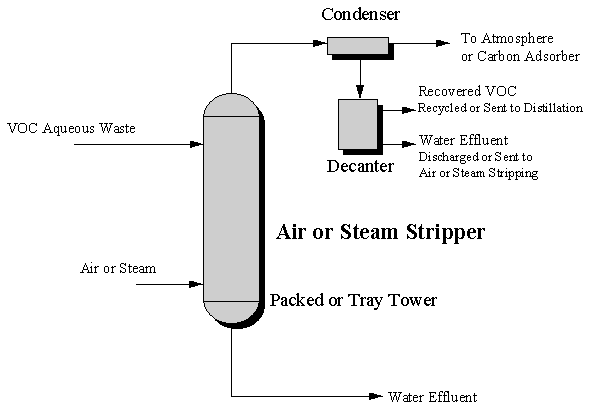Chapter II
VOC Separation Systems for Aqueous Wastes
Several technologies exist that can be used for recovering VOC's from aqueous wastes.
The most widely used technologies are air stripping, steam stripping and activated carbon
adsorption; however, several emerging membrane-based technologies, such as reverse osmosis
and pervaporation, have also shown potential for use in recovering VOC's from wastewater.
The following is a summary of these technologies, a description of the technology, and
some advantages and disadvantages of these technologies. Additional information and
modeling equations of these mass transfer operations can be found in literature such as
McCabe et al. (1993), Perry and Green (1984), Geankoplis (1983), Henley and Seader (1981),
King (1980), and Treybal (1980). Destructive technologies, such as biodegradation, are not
reviewed since this work focuses solely on recovery technologies.
VOC Recovery Technologies for Aqueous Wastes
|
Air Stripping
(Heilshorn, 1991a; Heilshorn, 1991b; Fleming, 1989; Okoniewski, 1992) |
Description
- Wastewater flows into the top of a packed column and is distributed throughout the
packing.
- Air flows into the bottom of the column and the VOC is transferred from the wastewater
to the air via direct contact.
- The VOC-laden air exits the top of the column and the VOC is subsequently condensed from
this gas stream prior to emitting the stream to the environment.
- "VOC-free" wastewater exits the bottom of the column.
Advantages
- Operating temperatures are lower than steam stripping which may protect sensitive column
internals or reduce compound degradation from these high temperatures.
- More effective for VOC's with higher volatility (lower boiling point).
- Preventive maintenance costs are typically low.
- System can usually be easily upgraded to strip greater amounts of VOC's with relatively
small increases in capital costs.
Disadvantages
- Maximum allowable concentration of VOC in the air exiting the stripper is limited by the
Lower Flammability Limit (LFL) of the VOC in exit air stream.
- Exceeding the LFL in the exit air stream may lead to fires and/or explosions in the
stripper or the subsequent air handling equipment/condenser.
|
Steam Stripping
(Heilshorn, 1991b; DeRenzo, 1981) |
Description
- Wastewater flows into the top of a packed or tray column and is distributed throughout
the column.
- Steam flows into the bottom of the column and the VOC is transferred from the wastewater
to the steam via direct contact.
- The VOC-laden steam exits the top of the column and the VOC is subsequently condensed
with the steam. If the VOC is immiscible in water, the condensate will form an aqueous
layer and a solvent layer that can be separated using a decanter. If the VOC is miscible
in water, additional distillation can be used to further separate the VOC and water.
- "VOC-free" wastewater exits the bottom of the column.
Advantages
- A widely used technology with well known operating characteristics.
- Operating temperatures are higher than air stripping, which presents a generally more
favorable equilibrium relationship.
- More effective for VOC's with lower volatility (higher boiling point).
- Can remove a wider range of VOC's.
- Allows a wider range of removal levels.
Disadvantages
- Higher operating temperatures than air stripping may accelerate equipment and/or
compound degradation.
- Some steam will condense and add to the hydraulic load of the system.
|
Figure 2.1
A Schematic Representation of an Air or Steam Stripping Process for VOC
Aqueous Wastes

Return to Table of Contents

